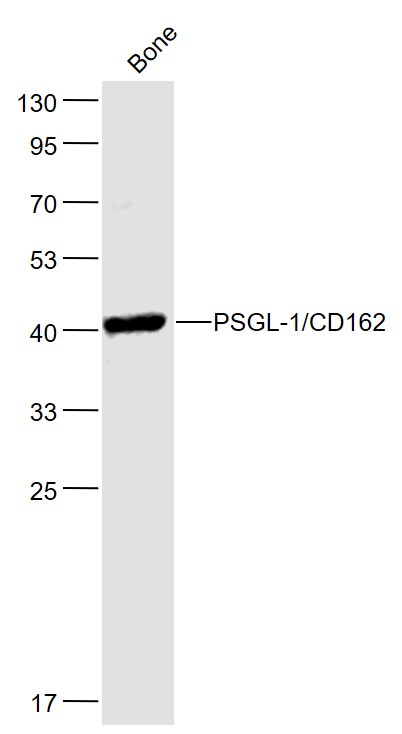
Rabbit Anti-PSGL-1/CD162 antibody
CD 162; CD162; CD162 antigen; CLA; Cutaneous lymphocyte associated associated antigen; P selectin glycoprotein ligand 1; P selectin glycoprotein ligand 1 precursor; P-selectin glycoprotein ligand 1; PSGL 1; PSGL-1; PSGL1; Selectin P ligand; SELPL_HUMAN; S
View History [Clear]
Details
Product Name PSGL-1/CD162 Chinese Name P选择素glycoprotein配体1抗体 Alias CD 162; CD162; CD162 antigen; CLA; Cutaneous lymphocyte associated associated antigen; P selectin glycoprotein ligand 1; P selectin glycoprotein ligand 1 precursor; P-selectin glycoprotein ligand 1; PSGL 1; PSGL-1; PSGL1; Selectin P ligand; SELPL_HUMAN; SELPLG. Research Area Cell biology immunology Cell adhesion molecule Cell Surface Molecule Immunogen Species Rabbit Clonality Polyclonal React Species Mouse, (predicted: Human, Rat, ) Applications WB=1:500-2000 ELISA=1:5000-10000 IHC-P=1:100-500 IHC-F=1:100-500 ICC=1:100-500 IF=1:100-500 (Paraffin sections need antigen repair)
not yet tested in other applications.
optimal dilutions/concentrations should be determined by the end user.Theoretical molecular weight 41kDa Cellular localization The cell membrane Form Liquid Concentration 1mg/ml immunogen KLH conjugated synthetic peptide derived from human PSGL-1/CD162: 301-400/412 <Cytoplasmic> Lsotype IgG Purification affinity purified by Protein A Buffer Solution 0.01M TBS(pH7.4) with 1% BSA, 0.03% Proclin300 and 50% Glycerol. Storage Shipped at 4℃. Store at -20 °C for one year. Avoid repeated freeze/thaw cycles. Attention This product as supplied is intended for research use only, not for use in human, therapeutic or diagnostic applications. PubMed PubMed Product Detail This gene encodes a glycoprotein that functions as a high affinity counter-receptor for the cell adhesion molecules P-, E- and L- selectin expressed on myeloid cells and stimulated T lymphocytes. As such, this protein plays a critical role in leukocyte trafficking during inflammation by tethering of leukocytes to activated platelets or endothelia expressing selectins. This protein requires two post-translational modifications, tyrosine sulfation and the addition of the sialyl Lewis x tetrasaccharide (sLex) to its O-linked glycans, for its high-affinity binding activity. Aberrant expression of this gene and polymorphisms in this gene are associated with defects in the innate and adaptive immune response. Alternate splicing results in multiple transcript variants.[provided by RefSeq, Apr 2011].
Function:
A SLe(x)-type glycan, which through high affinity, calcium-dependent interactions with E-, P- and L-selectins, mediates rapid rolling of leukocytes over vascular surfaces during the initial steps in inflammation. PSGL1 is critical for the initial leukocyte capture.
Subunit:
Homodimer; disulfide-linked. Interaction with P-, E- and L-selectins, through their lectin/EGF domains, is required for promoting recruitment and rolling of leukocytes. These interactions require sialyl Lewis X glycan modification but there is a differing dependence for tyrosine sulfations. Sulfation on Tyr-51 of PSGL1 is most important for high affinity L-selectin/SELL binding while P-selectin/SELP requires sulfation on Tyr-48. E-selectin/SELE binds with much lower affinity and requires the sLe(x) epitope, but apparantly not tyrosine sulfation. Dimerization appears not to be required for P-selectin/SELP binding. Interacts with SNX20. Interacts with MSN and SYK; mediates the activation of SYK by SELPLG.
Subcellular Location:
Membrane; Single-pass type I membrane protein.
Tissue Specificity:
Expressed on neutrophils, monocytes and most lymphocytes.
Post-translational modifications:
Displays complex, core-2, sialylated and fucosylated O-linked oligosaccharides, at least some of which appear to contain poly-N-acetyllactosamine with varying degrees of substitution. Mainly disialylated or neutral forms of the core-2 tetrasaccharide, Galbeta1-->4GlcNAcbeta1-->6(Galbeta1-->3)GalNAcOH. The GlcN:GalN ratio is approximately 2:1 and the Man:Fuc ratio 3:5. Contains about 14% fucose with alpha-1,3 linkage present in two forms: One species is a disialylated, monofucosylated glycan, and the other, a monosialylated, trifucosylated glycan with a polylactosamine backbone. The fucosylated forms carry the Lewis antigen and are important for interaction with selectins and for functioning in leukocyte rolling. The modification containing the sialyl Lewis X glycan is on Thr-57. No sulfated O-glycans. Some N-glycosylation.
Sulfation, in conjunction with the SLe(x)-containing glycan, is necessary for P- and L-selectin binding. High affinity P-selectin binding has a preferred requirement for the isomer sulfated on both Tyr-48 and Tyr-51, whereas L-selectin binding requires predominantly sulfation on Tyr-51 with sulfation on Tyr-48 playing only a minor role. These sulfations play an important role in L- and P-selectin-mediated neutrophil recruitment, and leukocyte rolling.
DISEASE:
Defects in SELP may be a cause of susceptibility to ischemic stroke (ISCHSTR) [MIM:601367]; also known as cerebrovascular accident or cerebral infarction. A stroke is an acute neurologic event leading to death of neural tissue of the brain and resulting in loss of motor, sensory and/or cognitive function. Ischemic strokes, resulting from vascular occlusion, is considered to be a highly complex disease consisting of a group of heterogeneous disorders with multiple genetic and environmental risk factors.
Similarity:
Belongs to the selectin/LECAM family.
Contains 1 C-type lectin domain.
Contains 1 EGF-like domain.
Contains 8 Sushi (CCP/SCR) domains.
SWISS:
Q14242
Gene ID:
6404
Database links:Entrez Gene: 6404 Human
Omim: 600738 Human
SwissProt: Q14242 Human
Unigene: 591014 Human
Unigene: 215585 Rat
PSGL-1广泛分布于免疫细胞表面,在生物体内可与P、L、E选择素结合。在炎症发生、发展中有重要作用.Product Picture
References (0)
No References
Bought notes(bought amounts latest0)
No one bought this product
User Comment(Total0User Comment Num)
- No comment



 +86 571 56623320
+86 571 56623320
 +86 18668110335
+86 18668110335

